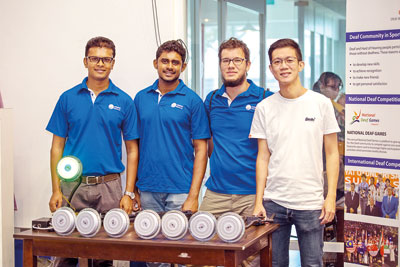SwimSight: A sound of hope for deaf swimmers
According to the World Health Organization 5% of the world population which is approximately 466 million people suffer from disabling hearing loss. It is projected that every one in ten people will have disabling hearing loss by 2050. As the number of individuals with hearing impairments keeps growing there is a need to ensure that society provides equal rights and facilities to those who are hearing impaired to enjoy the same benefits as others.

Prof. Suranga Nanayakkara (left) with the SwimSight research team
Identifying this need, Professor Suranga Nanayakkara, the founder and principal investigator of the Augmented Human Lab ( www.ahlab.org ) at the Singapore University of Technology and Design together with his group of research engineers Samitha Elvitigala, Daniel Wessolek, Attila Victor Achenbach and Chanaka Singhabahu has come up with a novel practical solution to overcome one of the difficulties faced by swimmers with hearing difficulties.
They have introduced “SwimSight”, a state-of-the-art start time indication system for deaf swimmers which has succeeded in eliminating the limitations associated with existing systems. In sports competitions, contestants anticipate the sounds “On your mark”, “Set”, “Go” to begin the game. These starting auditory instructions are not just mere signals given to participants in order to make sure that everyone starts the game at the same time, they also allow competitors to get ready and be on alert to start the game. Each one of these signals show different stages of mental and physical preparedness of the participant. At present, the professional timing systems utilized in most track and field events use auditory signals to provide starting instructions to competitors. Some of these timing systems come with a green colour LED, which flashes with the “GO” signal.
However, competitors with hearing difficulties find it difficult to cope with currently available timing systems as they are unable to hear these auditory starting signals. Therefore, additional visual signals should be provided to deaf contestants to make sure that they receive the same state of mental and physical readiness as contestants with normal hearing. Currently utilized professional timing systems are unable to provide this complete preparedness.
“We believe that technology should not make people feel disabled and assistive devices used in sports should be more inclusive and intuitive. Our goal was to bridge the gaps in existing systems and design an innovative start time indication system to support swimmers with hearing impairments,” said the mastermind behind SwimSight, Professor Suranga Nanayakkara.

Swim Sight being used at the Singapore National Deaf Games
SwimSight has been designed to be plugged-and-played to existing professional timing systems. “Our research team collaborated with the Deaf Sports Association Singapore to involve the end users in the design process right from the beginning. Applying user-centred design processes via interviews, user case studies and prototyping with deaf swimmers and technical staff, we were able to design the SwimSight to provide maximum benefits to its users,” Professor Suranga explained.
The key features of SwimSight includes compatibility with the existing commercial timing systems, synchronization with the professional timing devices in providing timing accuracy, adaptability to different swimming styles, and its rugged design to withstand the exposure to water.
SwimSight had been successfully deployed at the Singapore National Deaf Games which was held in 2017 and received positive feedback from deaf swimmers who benefited from the new start time indication system. Deaf swimmers have mentioned that the SwimSight had improved their concentration, adjustability and the confidence in getting ready to start swimming when the light turns green with the “Go” signal.
“Our efforts to assist deaf athletes will not stop with SwimSight’s success story. We aim to design and develop sound-to-visual substitution systems to support other sports events in the near future,” stated Professor Suranga emphasising his research team’s focus on conducting cutting-edge research in assistive and rehabilitative technology.
This would definitely be good news to sportsmen/women with hearing impairments as they will be able to compete with ordinary contestants without compromising their talent due to external factors.


